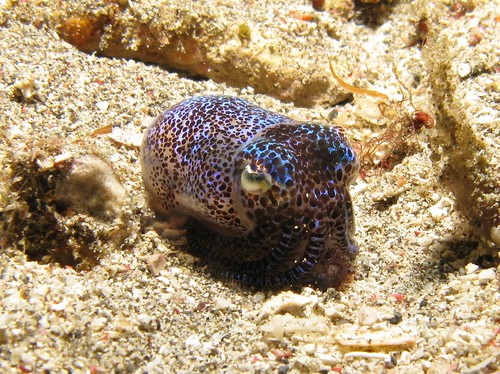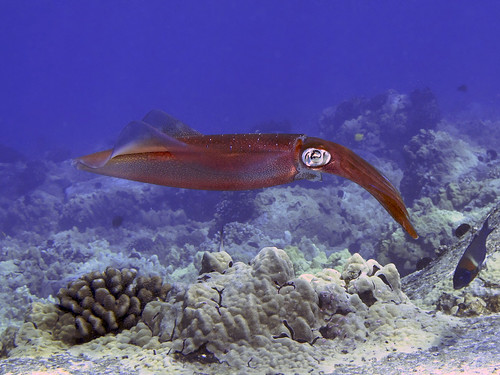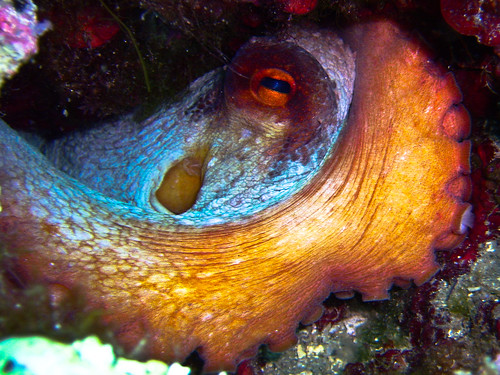1. The vampire squid from hell, for example, was caught with globs of mucus and feces in its mouth--destroying its fearsome image as terror of the deep (which was already belied by its huge blue eyes). Proceedings of the Royal Society B, New Scientist, NYT, Mercury News, CBS, Squid A Day.
2. Another unusual deep-sea species, Octopoteuthis deletron, was found to shed the tips of its arms when spooked. Not quite as gross as certain other defenses against predation, but not really something to be proud of, either. (You may also remember O. deletron for its open-minded mating strategy, discovered a little over a year ago.) Marine Ecology Progress Series, Science NOW, Smithsonian, Wired, Reuters.

Bobtail squid in Indonesia by prilfish
3. Speaking of sex, did you see that some of the shortest cephalopods have some of the longest copulation times? The adorably truncated dumpling squid can mate for up to three hours--the equivalent time relative to lifespan for humans would be a week--and afterward are, understandably, exhausted. Biology Letters, The Independent, LA Times, BBC, io9, Squid A Day.
4. Less titillating and more straight-up horrifying, we learned that squid spermatophores can burrow into your mouth, if you happen to take a bite of a male squid whose internal organs are still intact. Take-home lesson? Remove spermatophores from squid before eating. Or, if you're a squid sperm researcher, grab the opportunity to study the mechanism of these tiny yet complex structures. Journal of Parasitology, Zoomorphology, Squid A Day, io9, ABC News, Gothamist.
5. On the topic of tiny complex structures, iridophores were hot this year! The long-standing mystery of how cephalopods control these reflective units in their skin was finally solved: they change what color is reflected by sending electrical signals from their brains. (This research inspired the viral video of squid skin dancing to Cypress Hill, though it should be noted the active structures in the video are chromatophores, not iridophores.) Proceedings of the Royal Society B, LiveScience, National Geogrpahic, KQED.

Oval squid in Hawaii by SteveD
6. As if changing colors and iridescence weren't magical enough . . . did you know squid can fly? Seriously. And not only can they fly, they actually seem to conserve energy by doing so. 2012 Ocean Sciences, Nature News, Discovery News, Discover, Squid A Day.
7. So far, flying squid haven't been seen to use their powers for predation--they don't attack albatrosses or pelicans in mid-air. But their octopus cousins have found a way to dine on fowl without any need for flight. Yes, an octopus ate a seagull.
8. In fact, it sometime seems as if octopuses exist to remind us chordates that we're not always the bosses. Exhibit A: this supremely confident rogue pushed a shark aside in order to steal a scientist's bait container.

Octopus in Mallorca by DanTheBeastMan
9. Faced with such intelligence, we can't help imagining what would happen if we could truly communicate with these creatures. So on April 1st, a group of researchers developed gesture to speech translation for an octopus . . . and discovered that it has nothing polite to say.
10. But surely they're more civil when communicating with each other? See for yourself in Texts from Cephalopods. (I couldn't help adding a dialogue of my own.)
That's it! Happy Cephalopod Awareness Days, everyone! Also check out: Weird Traits that Make Octopuses and Squid Lovable, Noadi's Cephalopod Art Sale and Giveaway, and of course the official ICAD tumblr.
Thanks to Billy Hung and Ralf Muschall for suggesting stories to include.





Comments